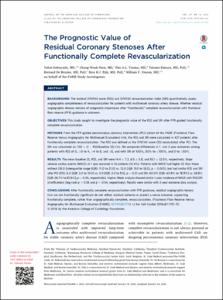KUMEL Repository
1. Journal Papers (연구논문)
1. School of Medicine (의과대학)
Dept. of Internal Medicine (내과학)
The Prognostic Value of Residual Coronary Stenoses After Functionally Complete Revascularization.
- Affiliated Author(s)
- 남창욱
- Alternative Author(s)
- Nam, Chang Wook
- Journal Title
- Journal of the American College of Cardiology
- ISSN
- 0735-1097
- Issued Date
- 2016
- Keyword
- Fractional flow reserve; Multivessel revascularization; Residual SYNTAX score; SYNTAX revascularization index
- Abstract
- BACKGROUND The residual SYNTAX score (RSS) and SYNTAX revascularization index (SRI) quantitatively assess
angiographic completeness of revascularization for patients with multivessel coronary artery disease. Whether residual
angiographic disease remains of prognostic importance after “functionally” complete revascularization with fractional
flow reserve (FFR) guidance is unknown.
OBJECTIVES This study sought to investigate the prognostic value of the RSS and SRI after FFR-guided functionally
complete revascularization.
METHODS From the FFR-guided percutaneous coronary intervention (PCI) cohort of the FAME (Fractional Flow
Reserve Versus Angiography for Multivessel Evaluation) trial, the RSS and SRI were calculated in 427 patients after
functionally complete revascularization. The RSS was defined as the SYNTAX score (SS) recalculated after PCI. The
SRI was calculated as: 100 (1 RSS/baseline SS) (%). We compared differences in 1- and 2-year outcomes among
patients with RSS of 0, >0 to 4, >4 to 8, and >8, and with SRI of 100%, 50% to <100%, and 0 to <50%.
RESULTS The mean baseline SS, RSS, and SRI were 14.4 7.2, 6.5 5.8, and 55.1 32.5%, respectively. Major
adverse cardiac events (MACE) at 1 year occurred in 53 patients (12.4%). Patients with MACE had higher SS than those
without (18.0 [interquartile range (IQR): 11.0 to 21.0] vs. 12.0 [IQR: 9.0 to 18.0], p ¼ 0.001), but had similar RSS and SRI
after PCI (RSS: 6.0 [IQR: 3.0 to 10.0] vs. 5.0 [IQR: 2.0 to 9.5], p ¼ 0.51 and SRI: 60.0% [IQR: 40.9% to 78.9%] vs. 58.8%
[IQR: 26.7% to 81.8%], p ¼ 0.24, respectively). Kaplan-Meier analysis showed similar 1-year incidence of MACE with RSS/SRI
stratifications (log-rank p ¼ 0.55 and p ¼ 0.54, respectively). Results were similar with 2-year outcome data analysis.
CONCLUSIONS After functionally complete revascularization with FFR guidance, residual angiographic lesions
that are not functionally significant do not reflect residual ischemia or predict a worse outcome, supporting
functionally complete, rather than angiographically complete, revascularization. (Fractional Flow Reserve Versus
Angiography for Multivessel Evaluation [FAME]; NCT00267774)
- Department
- Dept. of Internal Medicine (내과학)
- Publisher
- School of Medicine
- Citation
- Yuhei Kobayashi et al. (2016). The Prognostic Value of Residual Coronary Stenoses After Functionally Complete Revascularization. Journal of the American College of Cardiology, 67(14), 1701–1711. doi: 10.1016/j.jacc.2016.01.056
- Type
- Article
- ISSN
- 0735-1097
- Appears in Collections:
- 1. School of Medicine (의과대학) > Dept. of Internal Medicine (내과학)
- 파일 목록
-
-
Download
 oak-2016-0252.pdf
기타 데이터 / 1.52 MB / Adobe PDF
oak-2016-0252.pdf
기타 데이터 / 1.52 MB / Adobe PDF
-
Items in Repository are protected by copyright, with all rights reserved, unless otherwise indicated.